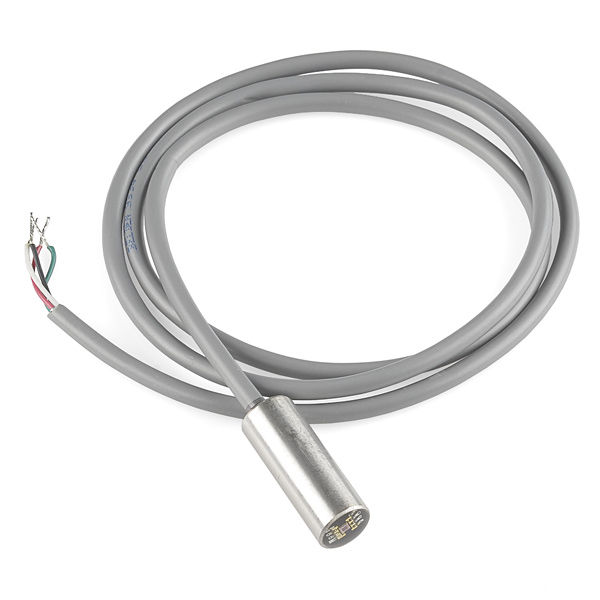Color Detector Sensor
This page describes a color detector sensor made by Atlas Scientific and how to use it to implement a BriteLED chasing demo.
Description
Atlas Scientific is on a mission to make high-quality sensors for environmental monitoring available to everyday hackers and makers. All of their kits are easy to calibrate and connect to your microcontroller-based project. https://www.sparkfun.com/products/11195
Features
https://www.sparkfun.com/products/11195
- R,G,B data is in true 8-bit RGB format from 0-255
- light intensity is output in lux (lx)
- lx given for R ,G and B as well as full spectrum lx
- RGB color data and lx can be output simultaneously
- lx range from 0- 3,235 lux
- Light saturation indicator if lx is over 3,235
- Three different output modes:
- RGB only
- Lx only
- RGB and lx
- Data output is a single comma separated string
- Simple RS-232 connectivity (voltage swing 0-VCC)
- Harsh environment ready: NEMA 6P and IP 68 rated
- Wide operating temperature range: -40 Celsius to +85 Celsius
- Simple instruction set consisting of only 5 commands
- Reading time: 620ms
- Wide operating voltage range: 3.1V to 5.5V
- Shock resistant to 16 mega Pascals

Refresh Rate
This color sensor can only take a measurement every 620 millisecond.
Wiring


| mbed | shiftbrite with random color | shiftbrite with color sensor |
|---|---|---|
| p5 | DI | |
| p7 | CI | |
| p22 | LI | |
| p21 | E1 | |
| p11 | DI | |
| p13 | CI | |
| p15 | LI | |
| p23 | EI |
Code
/* This program demonstrates the ability of a color sensor made by
* Atlas Scientific through a shiftbrite LED chasing game.
* Bi Ge bge6@gatech.edu
*/
#include "mbed.h"
DigitalOut latch(p15);
PwmOut enable(p23); // use PWM instead of DigitalOut to dim the LED
Serial color_sensor(p9, p10);
DigitalOut out_latch(p22);
PwmOut out_enable(p21);
SPI spi(p11, p12, p13); // the random shiftbrite
SPI out_spi(p5, p6, p7); // this shiftbrite is attached to the color sensor
// http://mbed.org/users/4180_1/notebook/shiftbrite1/
void RGB_LED(int red, int green, int blue)
{
unsigned int low_color=0;
unsigned int high_color=0;
high_color=(blue<<4)|((red&0x3C0)>>6);
low_color=(((red&0x3F)<<10)|(green));
spi.write(high_color);
spi.write(low_color);
latch=1;
latch=0;
}
/* This function is exactly the same as the one above, the only
* difference is now it outputs value to the second shiftbrite
*/
void out_RGB_LED(int red, int green, int blue)
{
unsigned int low_color=0;
unsigned int high_color=0;
high_color=(blue<<4)|((red&0x3C0)>>6);
low_color=(((red&0x3F)<<10)|(green));
out_spi.write(high_color);
out_spi.write(low_color);
out_latch=1;
out_latch=0;
}
void split_RGB(char* color_str)
{
char *save_ptr; // this ptr is used by strtok_r to save
// the current parsing state
char *p = strtok_r(color_str, ",", &save_ptr); // parse with ","
int red = strtol(p, NULL, 10);
p = strtok_r(NULL, ",", &save_ptr);
int green = strtol(p, NULL, 10);
p = strtok_r(NULL, ",", &save_ptr);
int blue = strtol(p, NULL, 10);
out_RGB_LED(red, green, blue);
return;
}
void get_color()
{
if(color_sensor.readable()) {
char str[11];
int i = 0;
char c;
/*
* The color sensor sends its output in form
* "rrr,ggg,bbb\r" in char. It can also output the
* light intensity. See product document.
*/
while(c=color_sensor.getc()) {
// wait for the carriage return
if(c!='\r') {
str[i] = c;
i++;
} else {
break;
}
}
split_RGB(str);
}
return;
}
int main()
{
int red=0;
int green=0;
int blue=0;
spi.format(16,0);
spi.frequency(500000);
out_spi.format(16,0);
out_spi.frequency(500000);
enable=0.5; // set PWM to half, full on is too bright
latch=0;
out_enable=0.5;
out_latch=0;
color_sensor.baud(38400);
wait(2);
while(1) {
red = rand() % 50;
green = rand() % 50;
blue = rand() % 50;
RGB_LED( red, green, blue);
/* IMPORTANT: The color sensor can only take a measurement every 620ms
* Have to wait for the instruction to complete.
*/
get_color();
wait(1);
}
}
Program
Import programmini
demo program of color sensor
Please log in to post comments.
